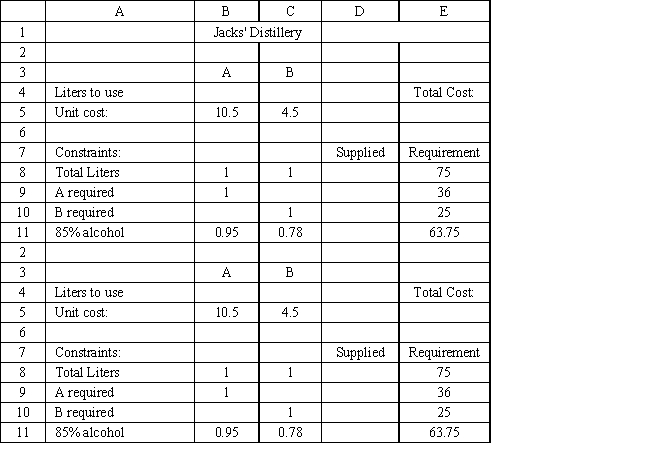Exhibit 3.3
The following questions are based on this problem and accompanying Excel windows.
Jack's distillery blends scotches for local bars and saloons. One of his customers has requested a special blend of scotch targeted as a bar scotch. The customer wants the blend to involve two scotch products, call them A and B. Product A is a higher quality scotch while product B is a cheaper brand. The customer wants to make the claim the blend is closer to high quality than the alternative. The customer wants 50 1500 ml bottles of the blend. Each bottle must contain at least 48% of Product A and at least 500 ml of B. The customer also specified that the blend have an alcohol content of at least 85%. Product A contains 95% alcohol while product B contains 78%. The blend is sold for $12.50 per bottle. Product A costs $7 per liter and product B costs $3 per liter. The company wants to determine the blend that will meet the customer's requirements and maximize profit. 

-Refer to Exhibit 3.3. Which cells should be the constraint cells in this problem?
Definitions:
Field Experience
Practical exposure and hands-on experience obtained in a real-life work environment within one's field of study or career interest.
German Piano Manufacturer
A company based in Germany specializing in the creation and production of pianos.
Joint Venture
A business arrangement where two or more parties agree to pool their resources for the purpose of accomplishing a specific task or business activity.
Repatriation
The process of returning a person to their country of origin or citizenship, often used in the context of employees returning home after international assignments.
Q11: Refer to the diagram. Arrows (3) and
Q33: The following linear programming problem has been
Q56: In solving the NLP problem, Solver produced
Q57: The assignment problem is equivalent to a
Q70: Jones Furniture Company produces beds and desks
Q76: The "invisible hand" refers to the many
Q108: Refer to the above tables. Suppose that
Q177: The slope of the typical production possibilities
Q228: The production possibilities curve illustrates the basic
Q236: The problems of aggregate inflation and unemployment